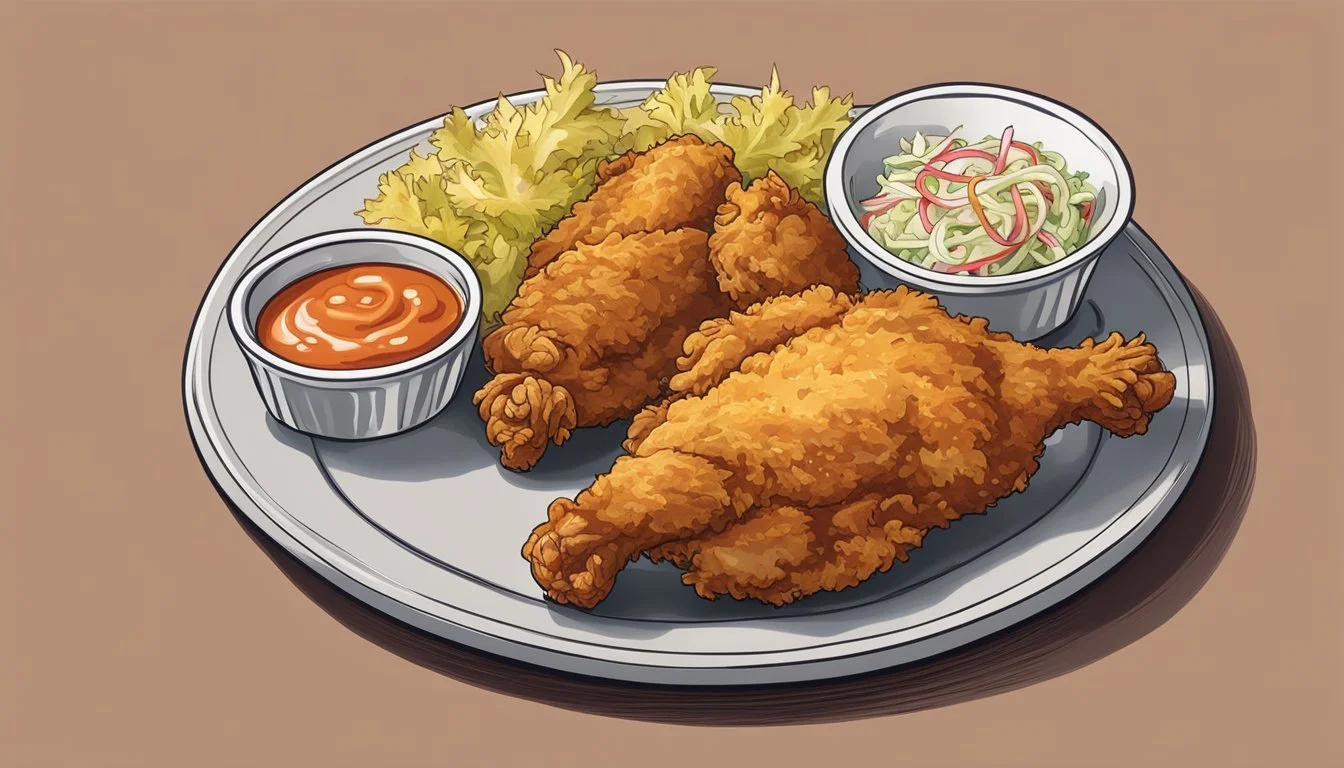How Do You Eat Fried Chicken?
Tips for Enjoying This Classic Dish
Eating fried chicken (how long does chicken last?)is a culinary experience that is deeply woven into American food culture. The dish is celebrated for its crispy exterior and juicy, flavorful meat. While seemingly simple, the way one partakes in fried chicken can vary depending on the setting and local customs. In a casual environment or when enjoying this hearty food at outdoor picnics, it is commonplace to eat fried chicken with one’s hands, feeling the satisfying crunch and savoring the spices that coat the skin.
In more formal dining settings or during a dinner party, the use of utensils may be preferred or expected. Diners often use a knife and fork to maintain etiquette, especially when in the company of guests or when greasiness is a concern. How one chooses to enjoy fried chicken also extends to personal taste regarding condiments and sides, with some opting for sauces like barbecue or honey mustard to complement the flavors, while others may prefer the simplicity of the seasoned coating on its own.
The conversation on how to eat fried chicken also involves acknowledging its impact on one's well-being. While indulging in this comfort food, it is important to consider that fried foods (What wine goes well with fried foods?) can contribute to bloating due to their high fat content and slower digestion process. Enjoying fried chicken in moderation as part of a balanced diet can offer the best of both worlds: the pleasure of its rich taste and the maintenance of health.
Brief History of Fried Chicken
Fried chicken, a staple of American cuisine, especially in the South, has origins that date back to ancient traditions. The method of deep-frying chicken in fat is an old practice, but it was the Scottish who were particularly known for not seasoning their fried chickens before cooking.
The dish was brought to America where it underwent a transformation in the Southern states. African slaves added seasonings and spices, greatly influencing the flavor profile of what is now considered traditional Southern fried chicken. This created a culinary legacy that not only delighted the palate but also established fried chicken as an American icon.
In many Southern homes, fried chicken is traditionally served with sides such as:
Mashed potatoes
Collard greens (how long do collard greens last?)
Cornbread
Biscuits
Macaroni and cheese
These sides complement the crispy texture and savory taste of the fried chicken, making it a comprehensive meal. The introduction of fried chicken into the American restaurant scene further solidified its popularity. It became a menu staple, inviting diners to savor this comfort food beyond the confines of their domestic kitchens.
Today, fried chicken is celebrated in restaurants across the country, reflecting the regional flavors and cultural diversity of the nation. It transcends its humble beginnings to occupy a place of pride in American culinary tradition.
Essential Ingredients
The right selection of ingredients is crucial for creating fried chicken that is juicy, tender, and packed with flavor. From the cut of chicken to the breading and oil used, each choice directly affects the texture and taste of the final dish.
Choosing the Right Chicken
Selecting quality chicken is the foundation of delicious fried chicken. For a balanced combination of flavor and texture, use a mix of breast and drumsticks. Breasts provide a meatier bite, while drumsticks offer a juicy and flavorful experience due to their higher fat content.
Creating the Perfect Breading
A flavorful and crispy breading begins with a base of all-purpose flour or a flour mixture that can include cornstarch for added crispiness. The seasoned flour should incorporate spices like paprika, garlic powder, black pepper, and a hint of cayenne pepper for a touch of heat.
Selecting Oil and Understanding Smoke Point
Choose an oil with a high smoke point to ensure it can withstand the temperature needed for frying without burning. Peanut oil, vegetable oil, and canola oil are optimal choices, with peanut oil offering a particularly rich flavor and high smoke point fit for the task.
Seasonings and Flavor Enhancers
Salt and pepper are the fundamental seasonings for enhancing the natural flavor of chicken. Building on this base, consider integrating a blend of spices to suit your palate, which can range from garlic powder to cayenne pepper for those who prefer a spicy punch.
Utilizing Additional Coatings
To achieve an extra layer of flavor and texture, employ additional coatings such as an egg wash or buttermilk brine. Soaking chicken pieces in buttermilk or a concoction of milk and egg prior to dredging in the flour coating can elevate your fried chicken to new heights of tenderness and taste.
Preparation Techniques
In crafting the perfect fried chicken, each preparation step is crucial to ensure juicy, flavorful meat with a crunchy texture. From the initial brine to achieving the precise internal temperature, attention to detail is key.
Brining for Juiciness and Flavor
Brining the chicken is the first step toward guaranteeing juicy and flavorful results. A buttermilk brine—commonly made with a mixture of buttermilk, salt, and sometimes additional spices and herbs—serves a dual purpose. It keeps the meat tender and infuses it with flavor. A typical brine might consist of a large mixing bowl filled with 4 cups of buttermilk and ½ cup of salt, thoroughly stirring to dissolve the salt before adding the chicken. Cover and refrigerate for at least four hours, or for enhanced taste, overnight.
Coating the Chicken Evenly
The coating process directly affects the chicken's final texture. Begin by preparing a flour mixture—a blend of flour, seasoned flour, or a combination with spices of choice. Remove the chicken from the brine and allow excess liquid to drip off. Dredge the chicken pieces in the flour mixture, ensuring every part is evenly coated. For a more substantial crust, double-dipping is an option: first into the flour, then back into the brine, and once more into the flour.
Achieving the Correct Internal Temperature
The last crucial step is cooking the chicken to the right internal temperature. Heat oil in a suitable deep skillet or fryer to 350 degrees F. Carefully lower the chicken pieces into the hot oil, and maintain the temperature around 350 degrees F throughout the cooking process. It's imperative to use a thermometer to check that the internal temperature of the thickest part of the chicken reaches 165 degrees F for optimal safety and doneness. The result should be chicken that's cooked through with a crispy, crunchy exterior.
Cooking Methods
Preparing fried chicken involves choosing the right cooking method to achieve a crispy and golden-brown exterior. Mastery of oil temperature and cooking technique is crucial for the perfect result.
Deep Frying Basics
To deep fry chicken, one must submerge it entirely in hot fat, typically using a dutch oven or a cast-iron skillet. The chicken should be coated with a seasoned batter or flour mixture to enhance its flavor and texture. The oil's temperature is pivotal; it usually needs to be around 350 degrees F (175 degrees C) which is below the smoke point to prevent burning.
Alternative Cooking Techniques
Besides the traditional deep-frying method, chicken can also be cooked in a turkey fryer for larger batches or oven-fried for a less oily alternative. Oven-frying typically requires a higher temperature to ensure the chicken becomes crispy, and is a popular choice to produce a similar texture with less grease.
Monitoring and Controlling the Oil Temperature
Accurate oil temperature is key for perfectly fried chicken. One should use a thermometer to monitor the oil to maintain a consistent temperature throughout the cooking process. Oil that is too cool will absorb into the chicken, making it greasy, while excessively hot oil can cause the exterior to burn before the inside is thoroughly cooked.
Serving Suggestions
Serving fried chicken with well-chosen side dishes and garnishes can elevate the dining experience, balancing flavors and textures.
Appropriate Side Dishes
When planning for side dishes to accompany fried chicken, one should consider the setting and the flavor profile. For a picnic setting, portable and easy-to-eat sides such as coleslaw and cornbread are practical choices.
Potatoes: A versatile option, serving either as mashed potatoes with a hint of ranch or barbecue flavor for richness or as a cold potato salad for a refreshing side.
Beans: A bean salad or baked beans offer a flavorful complement that is both filling and satisfying.
Greens: Collard greens cooked with a touch of honey for sweetness or a fresh green bean salad for a crisp touch.
Mac and Cheese: A creamy and comforting macaroni and cheese dish can be a hearty addition to the meal.
Salad: A light, green salad dressed with a simple vinaigrette can add a fresh, healthy element.
Presentation and Garnishes
The presentation of fried chicken and its sides can significantly affect its appeal.
Garnishes: A squeeze of lemon can add a fresh zing to the chicken's flavor profile. Adding a sprig of parsley or dill can also enhance visual appeal.
Sauce Accompaniments: Small bowls of honey, barbecue sauce, or ranch dressing can be offered, allowing diners to personalize their dish with their preferred level of sweetness or tang.
By paying attention to these details, one can ensure that fried chicken is not only delicious but also appealing in presentation.
Dining Etiquette
When eating fried chicken, diners often ponder whether to use their hands or utensils and how to handle accompanying condiments while maintaining cleanliness.
Using Hands or Utensils
In casual settings, such as outdoor picnics or fast-food restaurants, it is entirely acceptable to eat fried chicken with your hands, as it is considered a finger food. However, in more formal situations, such as a sit-down dinner or higher-end restaurant, using a knife and fork is the expected norm. When in doubt, observing the host or surrounding guests can provide guidance on appropriate conduct.
Accompanying Condiments and Sauces
Fried chicken is often paired with various condiments and sauces to enhance its flavor. Popular choices include:
Hot Sauce: Adds a spicy kick.
Barbecue Sauce: Provides a smoky sweetness.
Ranch: Offers a creamy counterbalance.
Honey: Delivers a touch of sweetness.
Ideally, sauces should be served in individual containers to avoid a messy serving area. Use a small spoon or tongs to add sauce to your plate, preventing contaminating the main supply.
Managing Greasiness and Cleanliness
Fried chicken can be greasy, so it is important to manage cleanliness while eating. Keep a napkin close at hand to dab away excess grease from your fingers or lips. If a sink is not nearby, restaurants often provide wet napkins. Placing a wire cooling rack in the serving dish can help keep chicken crispy by draining excess oil. Using utensils can also reduce the amount of grease transferred to your hands.
Storage and Reheating
When preserving and reviving fried chicken, the goal is to maintain safety and taste. Correct storage ensures that leftovers remain safe to eat, while the right reheating technique preserves the chicken's crispy texture.
Proper Cooling and Refrigeration
Before refrigerating fried chicken leftovers, they should be allowed to cool down to prevent raising the refrigerator's temperature, which can cause other foods to enter the danger zone. The safety guideline is to not leave fried chicken at room temperature for more than two hours to prevent bacterial growth.
Cooling: Allow chicken to cool uncovered, and ensure it's only slightly warm before refrigeration.
Refrigeration: Store in an airtight container—this keeps the chicken safe and minimizes moisture loss.
Reheating without Losing Texture
Reheating fried chicken so that it retains its crispy texture requires a gentle heat and a method that won't introduce too much moisture. The oven is often preferred because it can reheat evenly and maintain crispiness.
Oven Method:
Preheat your oven to 350°F.
Place chicken on a wire rack over a baking sheet to allow even heat circulation.
Heat until the internal temperature reaches 165°F, usually about 15-20 minutes.
Alternate Methods: An air fryer set to 350°F can also re-crisp chicken evenly, whereas a skillet can be used for a quick reheat if you add a thin layer of oil and cook at a medium heat until warm throughout.
Health Considerations
Eating fried chicken presents certain health considerations due to its high fat content and caloric density; thus, it is critical to acknowledge these factors and balance them with healthier options.
Understanding Fat Content and Calories
Fried chicken is a protein-rich food, which can be part of a nutritious diet; however, it often comes with a high fat and calorie count, particularly because of the frying process that makes it so juicy and appealing. The skin and breading contribute significantly to the overall fat and calorie content, which can affect one's health if consumed in excess. For a clearer perspective, refer to the table below that outlines average values for a typical piece of fried chicken:
Part of Chicken Calories Total Fat (g) Saturated Fat (g) Protein (g) Breast 390 23 6 39 Drumstick 120 7 2 11 Thigh 290 22 6 17 Wing 100 7 2 9
Consumers should consider these numbers when integrating fried chicken into their diet and be mindful of portion sizes.
Balancing with Nutritious Sides
To mitigate the health impact of fried chicken's fat and calories, it's advisable to pair it with nutritious sides. Options such as a light salad, steamed summer squash, or fresh tomatoes can introduce necessary vitamins and fiber to the meal. Here's a simple list of side dishes that complement fried chicken while adding nutritional value:
Salad: A mix of leafy greens like spinach and arugula, tossed with a vinaigrette dressing.
Summer Squash: Steamed or grilled with a dash of herbs.
Tomatoes: Sliced or in a salad, providing a refreshing taste and lycopene, an antioxidant.
Accompanying fried chicken with these wholesome sides can create a more balanced plate, which is particularly beneficial during the warmer summer months when lighter fare is often desirable.
Culinary Variations
Exploring the culinary variations of fried chicken reveals an array of flavors and techniques that reflect regional and cultural identities, as well as the unique qualities of homemade and restaurant-prepared dishes.
Regional and Cultural Adaptations
Fried chicken takes on many forms across the globe, shaped by local recipes and ingredients. In the Southern United States, traditional southern sides like coleslaw, biscuits, and gravy often accompany the crispy, seasoned skin and tender meat. The classic Southern recipe calls for a dredge of seasoned flour, creating a signature texture that's both crunchy and satisfying.
Moving to Asia, variations in countries like Korea introduce a double-fried method resulting in an even crispier outer layer, often paired with sweet and spicy sauces. These adaptations not only alter the texture and flavor but also how the chicken is served -- from street food vendors to family dining tables.
American adaptations are diverse, with hot and tangy sauces often preferred.
Asian recipes bring a balance of sweet, umami, and heat, making fried chicken a versatile dish in both casual and formal settings.
Homemade Versus Restaurant Styles
Homemade fried chicken has a comforting and traditional connotation. Cooks may follow handed-down family recipes, using simple ingredients to achieve a home-cooked taste that emphasizes the natural flavor of the chicken. Homemade versions can offer a personalized touch in seasoning, typically resulting in a less uniform but more distinct texture and flavor.
Conversely, restaurants, renowned for their fried chicken, strive for consistency. They often rely on deep fryers to achieve a precise texture and may serve their chicken with a variety of traditional Southern sides or offer a fusion of flavors reflecting the restaurant's theme. Restaurant styles may also highlight innovative methods and unique presentations to entice diners.
In both settings, fried chicken showcases varied textures, from the crunch of the breading to the juicy meat within.
Whether served with traditional southern sides or a modern twist, the dish remains a beloved staple of American comfort food and an adaptable canvas for culinary creativity around the world.
Tips and Tricks
Eating fried chicken with maximum enjoyment often involves savoring the perfect balance of a crispy and crunchy exterior complemented by a juicy, savory interior. The following tips focus specifically on enhancing those key sensory aspects of the fried chicken experience through crispiness and flavor.
Achieving the Ultimate Crispiness
For the crispest fried chicken, a few methods stand out:
Double Dredging: Coat the chicken pieces by dredging them in seasoned flour, dip into an egg wash, and then into the flour again. This process ensures a thick, adherent coating.
Proper Oil Temperature: The oil should be heated to a steady 350 degrees F (175 degrees C). Use a thermometer to maintain this temperature to prevent soggy outcomes.
Space Out the Chicken: Do not overcrowd the skillet. Too much chicken at once can cause the oil temperature to drop, leading to less crispy, more greasy chicken.
Flavor Enhancements and Experimentation
The key to enhancing the flavor of fried chicken lies within the seasoning and spices used:
Brining: Submerge the chicken in a mix of lukewarm water and salt before coating. Brining adds moisture and helps season the chicken through.
Spice Blends: Be bold with spices, whether using classic poultry seasonings or experimenting with unconventional ones like smoked paprika or a touch of cayenne for heat.
By meticulously managing the frying process and experimenting with seasonings, one can elevate fried chicken from merely good to gourmet.
Safety and Cleanliness
When consuming fried chicken, one's safety and cleanliness are paramount. Proper techniques during preparation and post-cooking processes are vital for maintaining hygiene and preventing foodborne illnesses.
Avoiding Contamination During Preparation
Hand Hygiene: Individuals should wash their hands thoroughly with soap and warm water before and after handling raw chicken.
Kitchen Surfaces: Kitchen counters and cutting boards need regular cleaning and sanitization, especially after coming into contact with raw chicken to prevent cross-contamination.
Tools and Utensils: Knives, bowls, and other utensils should be kept clean and, when possible, designated specifically for raw meat to avoid contaminating other foods.
Raw vs. Cooked: It's imperative to keep raw chicken separated from cooked or ready-to-eat foods. This minimizes the risk of transferring pathogens from the raw chicken to other food items.
Proper Disposal or Reuse of Oil
Cooling Oil: After cooking, oil should be allowed to cool completely before any attempt to dispose of or reuse it.
Storage for Reuse: If reusing, strain the cooled oil to remove food particles and then store in a clean, airtight container for future use. The number of reuses should be limited to maintain oil quality.
Disposal: When disposing of used cooking oil, one should never pour it down the drain. Instead, dispose of it in a sealed container in the trash, or even better, take it to a recycling center that accepts cooking oil.
Economic Considerations
Economic considerations play a significant role in the consumption of fried chicken. Consumers often seek a balance between enjoying this popular dish and managing their food budgets effectively.
Cost-Effective Buying Tips
Bulk Purchases: Families can save money by buying fried chicken in larger quantities at fast food establishments or grocery stores, which often offer family meals at a discounted rate.
Homemade Cooking: Preparing fried chicken at home using more economical cuts, like chicken thighs (What wine goes well with chicken thighs?), can significantly reduce meal costs.
Seasonal Sales: Taking advantage of sales and discounts on chicken can provide savings, especially when buying in bulk and freezing for later use.
Oil Choice: Utilizing affordable cooking oils such as canola or vegetable oil for frying chicken can keep costs down.
Reducing Waste with Leftovers
Creative Repurposing: Leftover fried chicken can be repurposed into other meals, such as chicken salads or chicken and dumplings, to stretch the economic value of the initial dish.
Proper Storage: Storing leftovers properly in airtight containers extends their life, ensuring that the food does not go to waste and provides additional meals.
Cost per Meal: Considering the cost of the entire chicken meal divided by the number of servings, including the additional meals made from leftovers, demonstrates the economical nature of fried chicken as a recurring menu item.
By following these strategies, consumers can enjoy fried chicken while addressing economic concerns, making it a budget-friendly option for individuals and families seeking both convenience and flavor.
Conclusion
Eating fried chicken is a delightful experience that is cherished in many communities. It provides not just a meal but an opportunity for people to engage in social interaction and cultural tradition. Fried chicken can be enjoyed in a variety of ways, with sauces such as barbecue, honey mustard, and hot sauce being popular options. Side dishes, including mashed potatoes, coleslaw, and macaroni and cheese, are customary and enhance the overall meal.
Selecting a perfect piece of fried chicken involves choosing one that is golden brown and crispy on the outside, while still maintaining juicy and tender meat inside. Regarding etiquette, it is acceptable to eat fried chicken with one's hands in informal settings, which can add to the communal and relaxed atmosphere of a meal shared with friends and family. In more formal settings, using utensils such as a fork and knife may be more appropriate.
Those who prepare fried chicken at home aim for a balance of taste and texture, often starting by brining the chicken to ensure it maintains its moisture during cooking. Fried chicken is not only a tasty option but a dish rich in protein and can be part of a balanced diet when consumed in moderation.
In essence, the culinary enjoyment of fried chicken is deeply embedded in various cultures and communities, signifying a sense of togetherness and gastronomic pleasure. Whether one prefers it classic, spicy, or dipped in sauce, fried chicken remains a versatile and universally appreciated dish.










